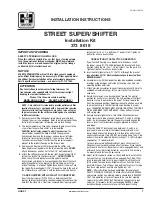
safety belts, because safety belts in modern vehicles are designed to
work as a safety system with the airbags.
Read all airbag warning labels in the vehicle as well as the other
important airbag instructions and warnings in this
Owner’s Guide.
NHTSA deactivation criteria (excluding Canada)
1.
Infant.
An infant (less than 1 year old) must ride in the front seat
because:
•
the vehicle has no rear seat;
•
the vehicle has a rear seat too small to accommodate a rear-facing
infant seat; or
•
the infant has a medical condition which, according to the infant’s
physician, makes it necessary for the infant to ride in the front so that
the driver can constantly monitor the child’s condition.
2.
Child age 1 to 12.
A child age 1 to 12 must ride in the front seat
because:
•
the vehicle has no rear seat;
•
although children ages 1 to 12 ride in the rear seat(s) whenever
possible, children ages 1 to 12 sometimes must ride in the front
because no space is available in the rear seat(s) of the vehicle; or
•
the child has a medical condition which, according to the child’s
physician, makes it necessary for the child to ride in the front seat so
that the driver can constantly monitor the child’s condition.
3.
Medical condition.
A passenger has a medical condition which,
according to his or her physician:
•
causes the passenger airbag to pose a special risk for the passenger;
and
•
makes the potential harm from the passenger airbag in a crash greater
than the potential harm from turning OFF the airbag and allowing the
passenger, even if belted, to hit the dashboard or windshield in a
crash.
Seating and Safety Restraints
110
2010 Econoline
(eco)
Owners Guide, 1st Printing
USA
(fus)















































